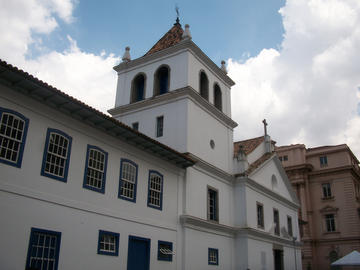Picture
More information on Padre Anchieta Museum

Description: Padre Anchieta Museum
Made up from donations and the return of some of the objects that originally belonged to the Church and the Jesuit College, the current collection of the museum is almost entirely exposed, without compliance with the criteria essential to their real characterization and subsequent recovery. The recent lementação museum and museological project allowed the objects that constitute the acquis could be identified, sorted, organized into collections and restored to reveal the value and credibility that they were carriers.
About 700 objects are part of the collections, now exhibited in almost all six rooms and space of the crypt. Indicators of memory, since many of the objects that comprise the assets have become a single reference to the history of the city of São Paulo, are no less interesting for the visitor in general, you can find in them the opportunity to establish a comparison with the their referents.
Model
It offers visitors the opportunity to geographically and historically situated opposite the sense that it has a place for the birth of the city of São Paulo, usually obscure or unknown to most of the people themselves. Different formats of memory, such as iconography unprecedented explanatory texts, maps and model, recently restored, promote the inclusion of Pateo the college in the context of the city and present a chronology of the transformations undergone by the site and witnessed from 1554 to the present day.
Font
A central element of the Museum, font symbolizes the meaning of the evangelical mission of the Society of Jesus in the indigenous populations of the Plateau.
Pinacoteca
The Museum's art gallery features twelve paintings of the XVII, XVIII and XX, all restored. In general, constitute representations of important events and personalities in the history of the Society of Jesus in Brazil.
Here are some of the works that make up this space:
Sacred Art
The area's most generous exhibition area is devoted to the Museum houses examples of his collection of religious art, which constitutes the largest part of the collection and reflects aspects peculiar to St. Paul. After the arrival of the Jesuits in 1554, the need for objects used for worship was originally supplied with the "import" copies of Portuguese or Spanish. However, the difficulties caused by isolation of the plateau eventually lead to a reinterpretation of European models, which took place and character of its own, unique and beautiful gerandouma production, residues of which reveal proximity to the scholar, from which single out particular images called "zebrafish ". Among the works of religious art are tables altar, chapels, crosses, reliquaries, monstrances, holy water fonts and other objects of worship and religious devotion reflect the Christian lands of São Paulo.
Baldachin
It features a single piece, a canopy, a kind of canopy supported by four columns currently used to provide protection for the monstrance bearing the "Blessed" or a shrine. It symbolizes the relationship between the earthly and heavenly, with Christ as the cornerstone of this connection.
Society of Jesus
It presents the fundamental aspects and assumptions of the Society of Jesus, his identity with Renaissance humanism, its development over time, especially the figure of Ignatius of Loyola, in order to create conditions for a more comprehensive understanding of the performance of the Company in Brazil and the world.
Crypt
The ancient crypt of the Church of the Collegio Pateo is now more a museum space. In this place are remains of walls built in the seventeenth century. Today it houses exhibits related to space Pateo the college and the history of the city of São Paulo.
Guest in general:
● Full: R$ 5,00.
● Students in private schools, students and teachers: R$ 2,50.
● Students in public schools (elementary and middle school): R$ 1.00
● Retirees, seniors, children under 7 years old and disabled: Exempt
http://www.pateocollegio.com.br/newsite/conteudo.asp?i=i1&pag_id=4
Photo by: Ca.mila OliveiraMore Photos of Picture

